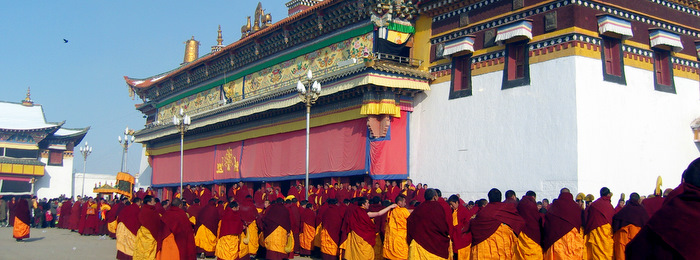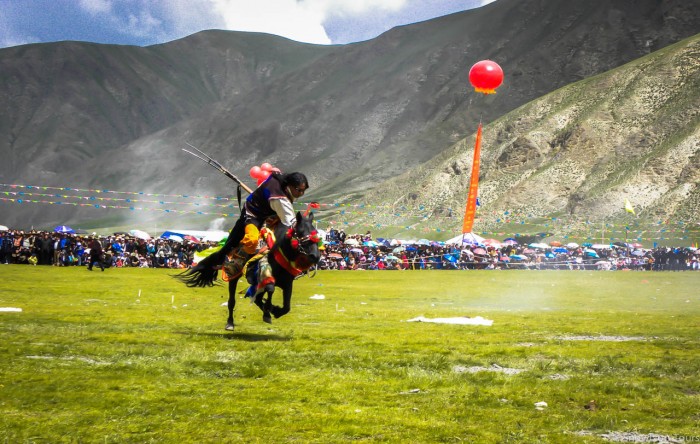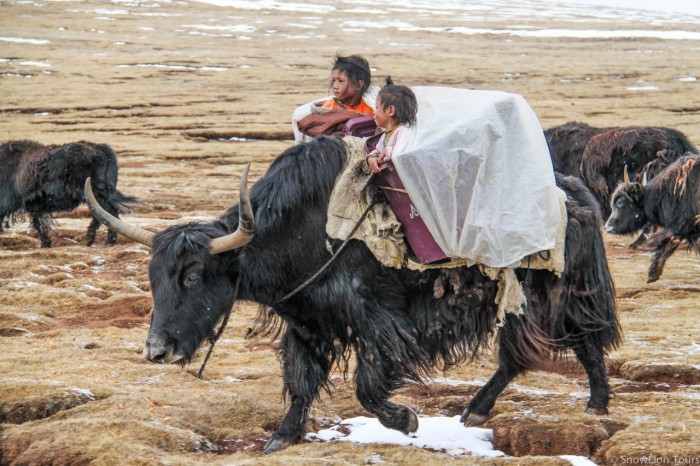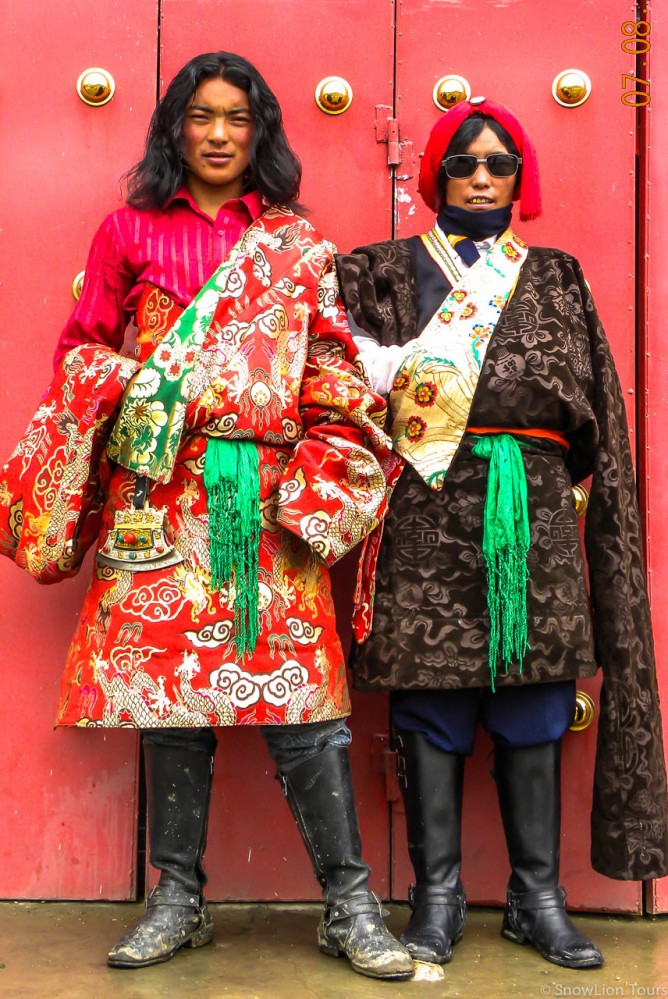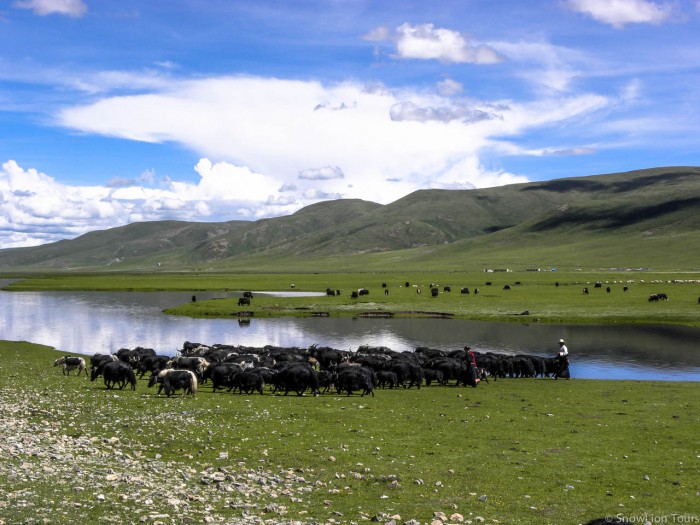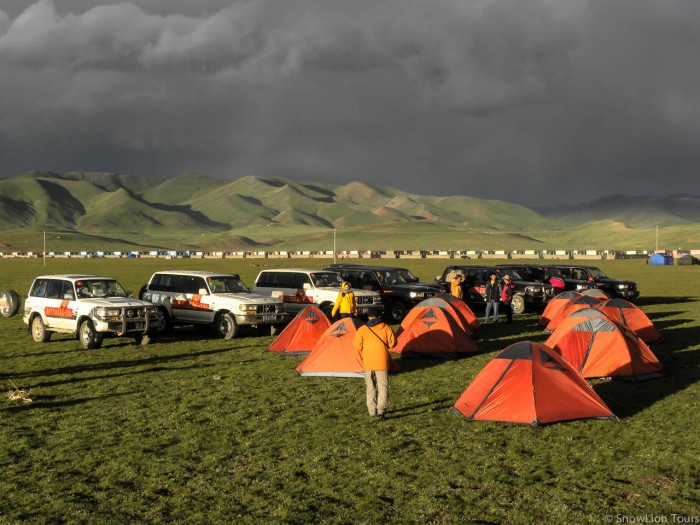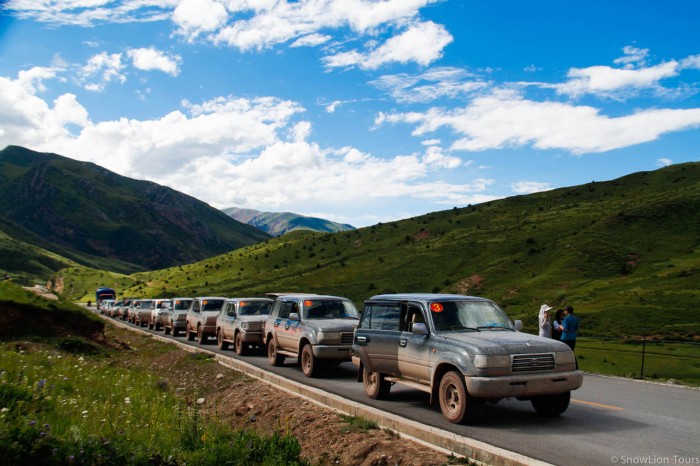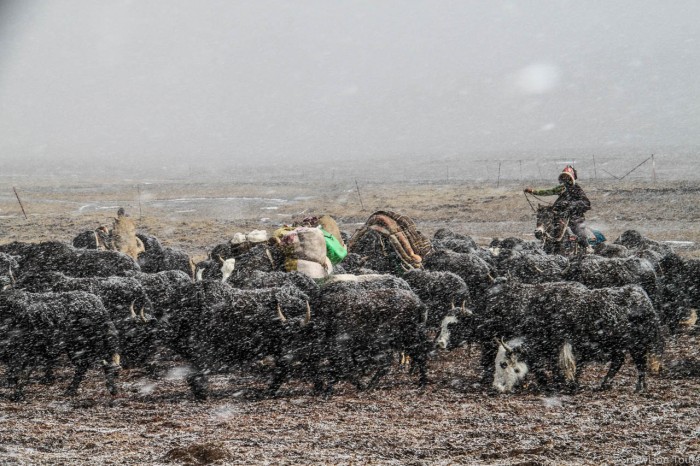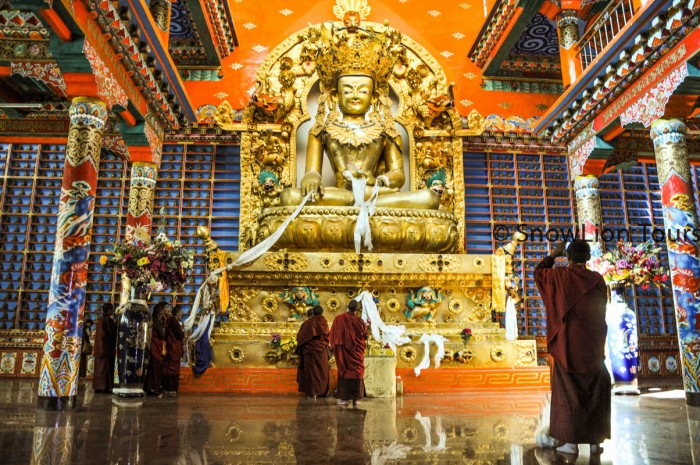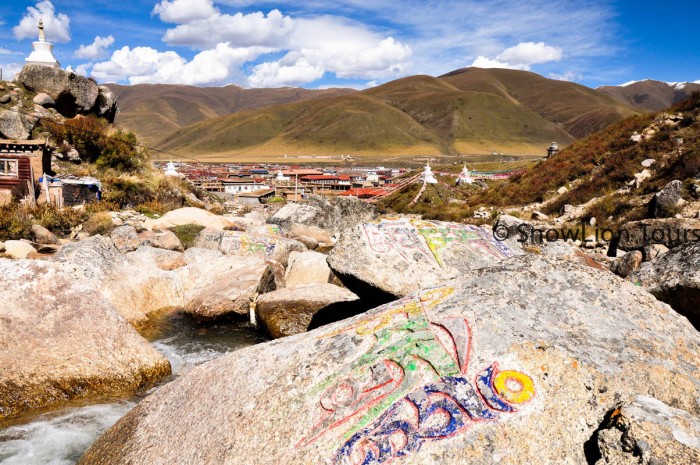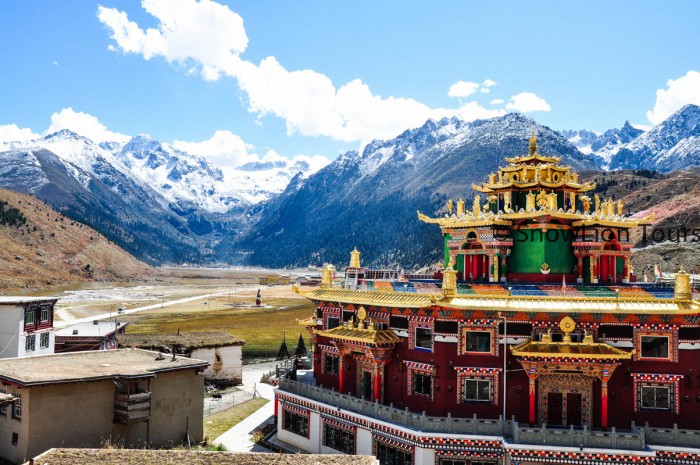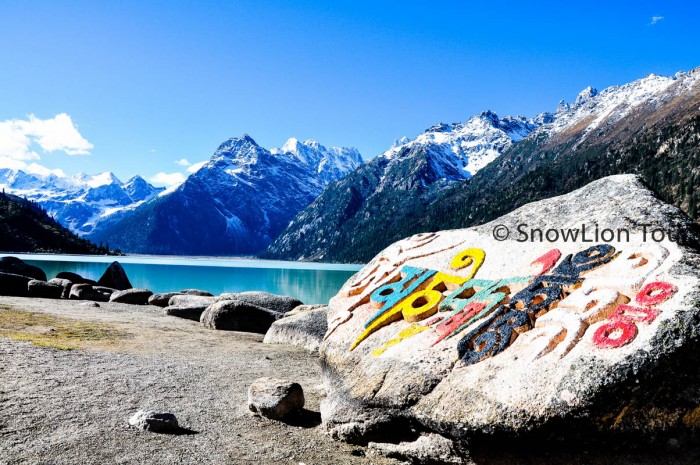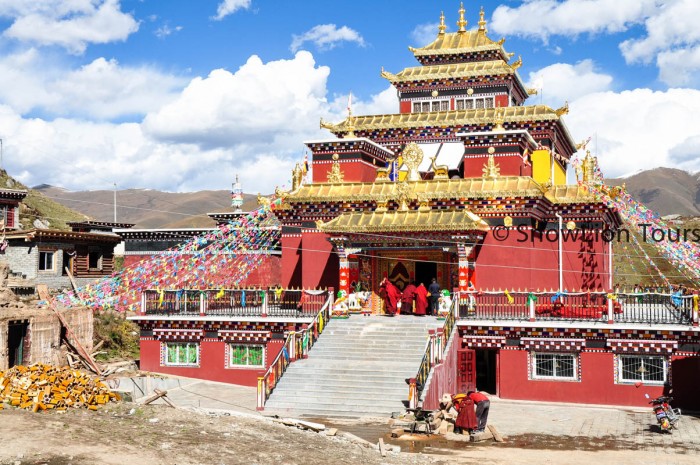Traveling across three provinces, this journey explores the unique cultural heritages of ancient tribes living in Eastern Tibet. Visit the famous lakes and monasteries of Amdo, the meditation caves of hermit monks, and the Batang grasslands. Offer a stone carving to the largest mani stone pile in the world, visit a traditional printing house in the cultural capital of Kham, and learn the legend of the black cranes at Napa Lake. Travel to Shangri-la and then on to Lijiang, where the locals maintain an ancient water-supply system of great complexity and ingenuity.
Route: Xining ⇒ Kumbum Monastery ⇒ Qinghai Lake ⇒ Tsigorthang ⇒ Dredzong Monastery ⇒ Mt. Amnye Machen ⇒ Lake Kyarang & Ngarang ⇒ Matoi ⇒ Jyekundo(Yushu) ⇒ Nambar Nangzel or Wencheng Temple ⇒ Jyeku Monastery ⇒ Gyanak Mani Stones ⇒ Sershul ⇒ Sershul Monastery ⇒ Dzogchen Monastery ⇒ Manigango ⇒ Yilhun Lhatso ⇒ Derge ⇒ Katok Monastery ⇒ Pelyul ⇒ Pelyul Monastery ⇒ Yachen Gar ⇒ Garze ⇒ Dawu ⇒ Nyakchuka ⇒ Litang ⇒ Chaktreng(Xiangcheng) ⇒ Shangri-la ⇒ Sumtsenling Monastery ⇒ Lijiang
Highlights
- Amdo, Kham, and Dongba cultures
- Ancient water supply system of Lijiang
- Mani stone pile of Jyekundo
Details
- 15-day trips begins in Xining, China, and ends in Lijiang, China
- 14 nights in hotels
- Average altitude of 3500m
Tour Costs
- E-mail us for an exact quote
- See Prices & Booking for more information
Departures
- Year-round
Day 1: Xining – Kumbum Monastery – Qinghai Lake – Tsigorthang [3303m] 385km, 6 hours
Visit Kumbum monastery, the birth place of Je Tsongkapa. Kumbum or full name Kumbum Jampa Ling is one of the six great monasteries of the Gelugpa school of Tibetan Buddhism, is famous for being the birthplace of the great religious reformer Tsongkhapa. It is a wonderful place to check out Tibetan religious culture, Tibetan architecture, and Tibetan arts. Highlights at the monastery include a large butter sculpture, murals and applique embroidery. Afterwards drive to 150km southwest to Qinghai Lake which is China’s largest lake and Asia’s largest salt Lake. After stop by at Qinghai Lake, we continue drive to Tsigorthang or Xinghai. Over night in Xinghai.
Day 2: Tsigorthang – Dredzong Monastery – Tsigorthang (Xinghai) [3200m], 60km (Hiking day)
Drive over rolling pastures to visit one of the most sacred monasteries in Amdo and its meditation caves. Drakar Tredzong monastery is also consider to be one of the holy sites in Tibet where the Guru Rinpoche used to do meditation. From Tsigorthang town to the monastery is just 30km one way. Today you will be doing a Kora around the holy rocky mountain behind the monastery in order to get acclimatized to the high elevation for the entire tour.
Note: The holy peak of Drakar Tredzong is encircled by a 3-4 hour kora route which crosses two passes and, along with its side-routes, offers access to the mountain’s sites and caves. There is also a chances to see the wildlife such as deers, monkeys.etc.
Day 3: Tsigorthang – View of Mt. Amnye Machen – Two sister lakes ( Lake Kyarang and Ngarang) – Matoi/Maduo [4400m], 530km, 8 hours
Continue drive southwest to Matoi / Maduo, On the way, make an excursion to visit Mt. Amnye Machen(4280m). Mt. Amnye Machen is one of four holiest mountain in Tibet. Then continue to Matoi/Maduo. After Matoi, we travel from Maduo to two sister lakes – Kyaring and Ngoring Lake, one of the main sources of the Yellow River. See wild donkeys and Tibetan antelopes. Take a short hike on the 4500m high Mt Tsori Katse located between the two stunning lakes. Tsori Katse monastery is also located just near the Ngoring lake. A Nyinmapa monastery which has very strong influence of Ling Gesar. Over night in Matoi
Day 4: Tsigorthang – Jyekundo (Yushu) [3670m], 580km 7 – 8 hours
Drive across grassland and over mountains and visit Tibetan nomads and their yak-hair tent along the way. yekundo or Yushu is a mojor Tibetan town located in the northwest region of Kham. Jyekundo town is found along the tributary of the Drichu(Tongtian He), which contribute to upper reach of mighty Yangtse River(Changjiang). It is a town with a long tradition of trade and center of Khampa culture. Overnight in Yushu.
Day 4: Jyekundo [3670m]
In the morning visit Nambar Nangzel or Wencheng Temple of Thragu monastery located 20km outside Jyekundo. The temple offers a Maha Varocaina Statue. According to the Buddhist interpretation, this statue has the equivalent blessing effects than the Buddha Sakyamuni Statue in Jokhang Temple in Lhasa. Afterwards drive back to town and visit Jyeku monastery and Gyanak Mani Stones. the hilltop overlooking Jyekundo had been the site of an ancient Bon temple, before Kagyupa temples were built alongside it. Then when Dragon Phakpa passed through in the course of his travel in 1268. He consecrated the site for the construction of a Sakya tradition monastery. Today Jyeku Monastery consist with 16 temples and home to more than 500 monks. Then visit Mani Stone Pile. Mani stones feature carved and painted Tibetan Buddhist mantras. At the Mani Stone Pile, mountains of rocks are stacked upon each other, and carvers sell mani stones nearby if you’d like to contribute to the pile. Pilgrims come from all over to circumambulate the stones. Overnight in Yushu.
Day 5: Jyekundo – Sershul (Shiqu) [4178m] 130km 3 -4 hours
Drive along the rolling pastures and mountains to reach Sershul Monastery. Dza Sershul Monastery was founded in 1760. It is one of the main Gelugpa centres in Kham, where all the genuine traditions of sutra and mantra were taught. Of the four great debate manuals (yigcha), they followed that of Sera Jé. Patrul Rinpoche taught there on a number of occasions and they later followed his tradition when teaching the Bodhicharyavatara. Afterwards drive to 20km north of the monastery to visit Barge Mani Stone Wall. This Mani Stones Wall is about 1750 meters long, and 3.5 meters in height; It is embedded with more than 3,000 stone statues and over 6,000 Buddhist scriptures including “Kanjur” and “Tengyur” the two Tibetan collection of commentaries to the Buddhist teachings. Afterwards drive back to Sershul monastery to watch the monks debating. Which will be started around 5:30pm every day. Overnight in Sershul Monastery.
Day 6: Sershul – Dzogchen Monastery – Manigango [3900m] 220km 5 – 6 hours
In the morning drive to Manigango via Dzogchen monastery. Dzogchen Monastery was established in 1684, by Pema Rigdzin, the 1st Dzogchen Rinpoche. Dzogchen Monastery was renowned for its college, the Shri Singha Shedra, named after the Dzogchen master Shri Singha, who sat down on a rock in the Rudam Valley of Tibet and left a miraculous imprint. In the 19th century, on that very spot, Gyalse Shenpen Thaye, a celebrated scholar and disciple of the 4th Dzogchen Rinpoche, Migyur Namkhe Dorje, built the Shri Singha Shedra. The 4th Dzogchen Rinpoche was the master of Patrul Rinpoche, Ju Mipham and many other great masters. If time allows. You can also visit Shechen monastery before reach Dzogchen monastery. Overnight in Manigangol
Day 7: Manigangol – Dege / Derge [3270m] 120km 3 hours
Drive to Lake Yilhun Lhatso which is just 20km from Manigango town and view the scared mountain Trola and its glaciers. In summer time it is much worth to take the Trola pass which offers the best mountain range view of Trola mountain with snow capped peaks. After arrive Derge. You will visit Derge Gonchen. The great monastery of Lundrub Teng (Dege Gonchen) was founded in 1448 by the first Dege King Tashi Sengge and the famous ascetic Tang Tong Gyalpo. On the way, we will stop by the rock paintings on the cliffs in the deep valleys. Overnight in Derge.
Day 8: Dege – Katok monastery – Pelyul [3000m] 150km 5 hours
In the morning visit Dege Parkang, a traditional printing house where many of Tibet’s Buddhist scriptures are still printed today. Afterwards drive to Pelyul via Katok monastery. Katok is the oldest of the Six “Mother” Nyingma Monasteries. It was founded by Katok Dampa Deshek, younger brother of Phagmodrupa Dorje Gyalpo, in 1159, above Horpo town. The site is considered to be one of twenty-five holy places of Eastern Tibet and represents the main holy place of enlightened activity. Afterwards drive to Pelyul.
Day 9: Pelyul – Yachen Gar – Garze [3350m] 220km 5 hours
In the morning visit Pelyul monastery. was built by Lhachen Jampa Phuntsog, the first Dharma King of Dege. It was constructed on a site which possesses all the essential auspicious signs and had been blessed by the presence of many great mahasiddhas. Afterwards drive to Garze via Yachen Gar. Yachen was founded by Akhyuk Rinpoche in the summer of 1980. It is located in an isolated valley 4,000m above sea level, During the 1990s, the population of monks and nuns grew to over 7,000. Recently there more than 10,000 Sangha members now, it is one of the largest gatherings of nuns and monks in the world.
Day 10: Garze – Dawu – Nyakchuka – Litang [4014m] 350km 6 – 7 hours
In the morning visit De Gonpa in the Garze center which has a great Shakyamuni statue in the main temple. Afterwards drive through Tibetan towns and villages dotted by beautiful designed houses. You will also cross some of the high elevated passes before Litang town. Here you will visit Litang Gonchen. Litang Gonchen or Litang Chokhor Ling is a major Geluk monastery that was founded in 1580 by the Third Dalai Lama, Sonam Gyatso on his return to Tibet from Mongolia.
Day 11: Litang – Chaktreng (Xiangcheng) [2900m] 259km 5 hours
In the morning drive to Chaktreng via vast grassland to Chaktreng valley. Visit Chaktreng Gompa or Xiangcheng Monastery, was originally built in 1669 and belongs to the Kagyu sect of Tibetan Buddhism. Later became Geluk sect of Tibetan Buddhism. The Chaktreng Monastery stands above the town and provides great views of the agricultural valley and stone houses. and then head to Napa Lake, where you can see black-necked cranes.
Day 13: Chaktreng – Shangri-la (Zhongdian) [3459m] 220km 5 hours
In the morning visit Sumtsenling monastery. The Sumtsenling monastery belonging to the Gelukpa order of Buddhism was established by the Fifth Dalai Lama in 1679. afterwards you could also explore the old town of Gyelthang or Shangrila.
Day 14: Shangri-la – Lijiang [2052m] 224km 6 hours
Visit ancient Naxi town – the architecture is especially noteworthy for the blending of elements from several cultures that have come together over many centuries. Lijiang maintains an ancient water-supply system of great complexity and ingenuity that is still functioning effectively.
Day 15: Depart Lijiang
Leave Lijiang via train or plane.
Itineraries are subject to change without prior notice.




